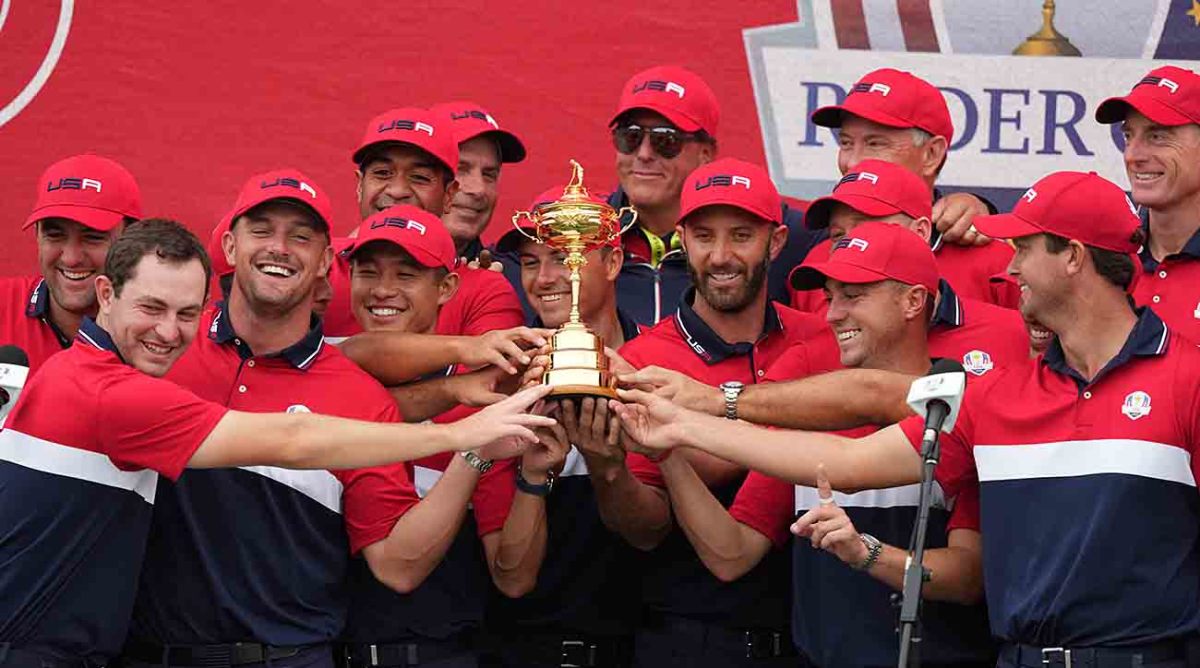The Ryder Cup Remains Great By Lacking One Thing: Prize Money

If money could indeed talk, there’s no telling what those dead presidents might say about the state of pro golf as it nears the quarter pole of the 21st century. Thirty-four players surpassed $5 million in PGA Tour earnings in 2023 alone, almost a third of which didn’t win a tournament. That proposed partnership with the PIF of Saudi Arabia amounts to an alliance for an allowance, as if commissioner Jay Monahan woke up one morning and realized he can’t ride piggyback on his piggy bank anymore.
No wonder the guy spent a few weeks on the shelf this summer. In poor health and endangered wealth, no medication is known to treat the effects of fiscal frivolity.
Maybe that’s a big reason why we’re so madly in love with the Ryder Cup. Not a dime of prize money involved—a staggering diversion to the norm in that the world’s best players will not only scale tall buildings to make the team, but arrive at their destination with a suitcase full of intensity and a stomach stuffed with nerves. Plenty of famous people do things on a voluntary basis, owing to the goodness in their heart and the residual value of the photo op. That’s a career move, not a three-day stay in the house of toxic pressure.

To say the premise almost crumbled 24 years ago would be an overstatement, but when several American players voiced strong objection to the lack of compensation for their Ryder Cup services about a month before the 1999 matches, the game’s patriotic partisanship reacted as if their flag had been dropped in a pile of volcanic ash. The beef reached a boil at the PGA Championship that August. Meetings were called, discussions were held and the matter was suitably settled—each member of the U.S. squad would have a portion of Ryder Cup revenue donated to their charity of choice.
And so the biennial bout was saved, albeit to fair warning. If the event were to ever pay its participants, the best weekend in golf would be ruined the same way steroids once destroyed Major League Baseball. Today’s players seem to fully understand that, and because they make so much bread throughout the season, they embrace the concept without pretense. The level of enthusiasm and competitive energy among both sides has never been more obvious, whereas Europe held a considerable advantage in both departments while assuming control of the series in the early 2000s.
This generation of Americans clearly cares. Having grown up watching the U.S. lose eight of the first 10 Ryder Cups held after its last overseas victory (1993), those young Yanks had to be affected by the perception that their home country was competitively inferior. The absence of financial incentive cultivated a widespread notion that America’s best players simply didn’t want to be bothered—and that the hungrier, more unified squad would win a lot more often than not.
Easy to believe, impossible to measure. Those are the theories that usually end up becoming gospel.
The roots can be traced to when the Great Britain & Ireland rosters were expanded to include all of continental Europe in 1979. That meant the addition of young Spaniard Seve Ballesteros, and things haven’t been the same since. America’s unequivocal dominance came to an end. Ballesteros's swift emergence as a spiritual leader was no less meaningful than his brilliance as a player, but it was his superior sense of self and thirst for match-play combat that transformed Europe from doormat to dynamo.
Half tactician, half magician. More than any person in its 96-year existence, Ballesteros is responsible for the Ryder Cup as we know it today. He made it competitive. He made it controversial. He made it suspenseful. He made it relevant. He groomed the atmosphere. He commanded the battleground. He carried the little old afterthought held in late September to places nobody ever saw it going, and by any sense of sound judgement, his cumulative impact qualifies as one of the most overlooked accomplishments in golf history.
As one of the Americans associated with the play-for-pay revolt in 1999, Tiger Woods incurred much of the wrath for Uncle Sam’s shortcomings against the vivacious Euros. For all his greatness in match play as an amateur, it took a while for Woods to get comfortable in the team environment. Or more specifically, hanging out with guys he spent the rest of the year pummeling on a regular basis.
Although he declined to publicly address his feelings regarding Ryder Cup compensation, Woods's best buddy Mark O’Meara was the lead voice on the topic, which turned Tiger into a popular target. He wasn’t all that social even after the U.S. rallied from a four-point deficit to defeat Europe in Boston that fall, nor was he exactly thrilled when 2004 skipper Hal Sutton paired him with Phil Mickelson in both Friday sessions, each of which ended in a loss.
Tiger and Philly Mick would gradually strengthen their relationship over the years, at least until Mickelson bolted to LIV Golf, but in the mid 2000s, the two were hardly chums. Lefty could get a bit loud in the U.S. team room and wasn’t shy about interjecting his opinions on strategy and pairings. Woods usually kept his thoughts to himself unless he was asked for his perspective, which was often. Neither man was consummate leadership material, and without its two best players serving as a guiding force, the U.S. struggled at almost every Ryder Cup in which they participated.
Their career records reflect that disappointment. Woods was 13-21-3, Mickelson 18-22-7. Tiger won just twice in eight appearances, and as one might suspect, was far more successful in singles matches (4-2-2) than in those with a partner (9-19-1).
Young Eldrick had just started his senior year of high school when America last won a Ryder Cup in Europe. The four most recent meetings have been blowouts, all won by the home squad, each by a greater margin than the one before it. America’s 10-point romp at Whistling Straits two years ago featured a very different team than the one assembled by Zach Johnson, but none of that data means a thing in the here and now.
They don’t play Ryder Cups on paper, and they don’t give any out once it’s over. When the United States clashes with Europe every other fall, dollars and cents are replaced by pride and flag. The best pairing in golf, regardless of the format.
